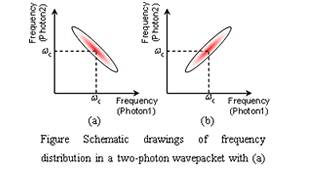Optical technology has been applied to various fields, such as optical measurement, imaging, and info-communication technology. However, the guiding principle of such technologies is still based on the gwave optics,h which can be understood by the behavior of photons without any correlation in terms of the particle picture of light. Recently, the generation of photons with quantum correlations has been realized due to the development of laser techniques and nonlinear optics, and these correlations are expected to overcome the limit determined by classical optics.
A quantum state of light is characterized by some physical degree of freedom (DOF): photon number, polarization energy, and wave vector. In particular, quantum correlation in polarization DOF (polarization entanglement) is applicable for proof-of-principle experiments of quantum information protocols, and that in transverse wavenumber allows us to achieve high-resolution imaging at subwavelength resolution. Meanwhile, quantum correlation in energy DOF can play a crucial role in light-matter interactions and optical measurements.
In semiclassical theory of light-matter interactions, which light is treated as classical quantity while the quantum mechanical treatment is required for matter, the use of an ultrashort laser pulse is the most appropriate way to study nonlinear optical responses. On the other hand, quantum mechanical correlation among the photons in a multi-photon wavepacket is expected to have a key role in light-matter interaction under the condition revealing the quantum nature of light. Actually, there exist multi-photon wave packets having the symmetrical properties from quantum mechanical point of view, whereas they have exactly the same properties in terms of the classical optics (see Figure). In this project, we exploit the methods to control the degree of freedoms in time-frequency domain and study the nonlinear optical response by the multi-photon wavepackets. The goal of this project is to clarify the optimal quantum state of light in light-matter interactions under extremely weak light, which depends on whether we require strong light-matter interaction or measurement of the ultra-fast phenomena in nonlinear optical response.

|

